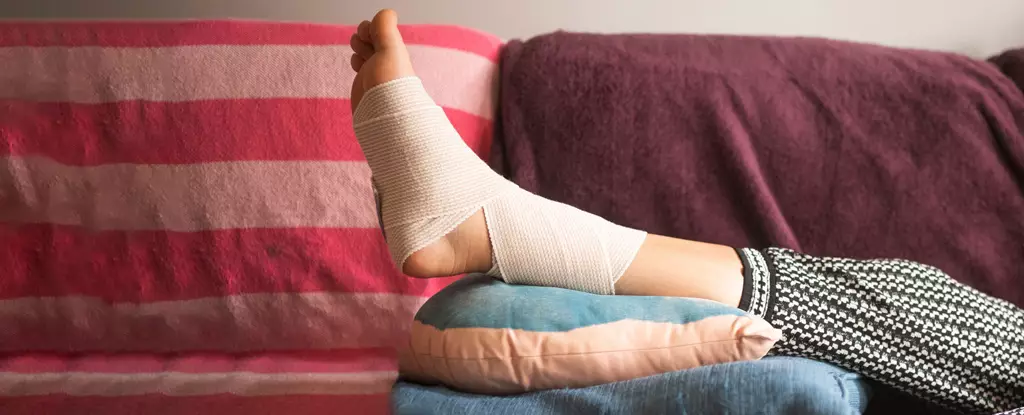When one thinks of an ankle sprain, the immediate imagery is often confined to the physical distress experienced in the joint itself. Yet, what if the implications of such an injury stretch far beyond the ankle? Recent research suggests a compelling link between physical injuries, such as ankle sprains, and underlying changes in brain function. This intersection between physicality and neurology is revealing a complex relationship known as brain plasticity. Our brains are not static repositories of information and responses; they are dynamic entities that adapt and reorganize in light of new experiences, including injuries.
Professor Ashley Marchant from the University of Canberra highlights intriguing findings that suggest a decrease in sensory accuracy related to lower limb movements when subjected to varied load conditions. Her work indicates that our brain’s perception of movement deteriorates as the load approaches a level lower than normal gravity. This revelation compels us to rethink traditional modalities of rehabilitation and athletic training, merging principles of neuroscience and sports medicine in unprecedented ways.
Historically, sports medicine has placed a strong emphasis on enhancing muscle strength, cardiovascular endurance, and flexibility as a means to rehabilitate injuries and enhance performance. However, this straightforward approach has overlooked a critical aspect: the altered neurophysiology following an injury. Astonishingly, even when athletes are cleared to resume activity post-injury, their likelihood of incurring another injury can increase twofold to eightfold. This cyclical pattern raises serious questions about conventional recovery protocols, suggesting critical elements related to sensory perception and brain function have been routinely ignored.
The Australian Institute of Sport’s recent investigations are attempting to address this oversight by focusing on sensory input and its role in movement control. By acknowledging that sensory neurons outnumber motor neurons by approximately ten to one, researchers are working toward a more nuanced understanding of how sensory engagement influences physical performance. The goal is to improve rehabilitation techniques by identifying which sensory systems may be underdeveloped or misaligned in the aftermath of an injury.
The Three Pillars of Sensory Input
One of the significant breakthroughs in current research lies in the ability to assess sensory input through three critical systems: the vestibular system for balance, the visual system for lighting changes, and the proprioceptive system responsible for spatial awareness in the limbs. The interplay of these sensors provides a comprehensive picture of one’s movement potential and challenges that can arise from injuries.
For instance, consider astronauts aboard the International Space Station, who often move with the aid of their arms, their legs dangling motionless behind them. In a microgravity environment, the sensory feedback from their legs becomes minimal, prompting the brain to deactivate its typical movement control pathways. Upon returning to a gravity-laden environment, these astronauts face heightened susceptibility to falls and injuries, a phenomenon remarkably familiar to athletes post-injury who must recalibrate their movement strategies.
The brain’s adaptation following injury is a double-edged sword; while it seeks to accommodate new movement patterns, it may inadvertently establish compensatory mechanisms that predispose an individual to further injury. For athletes, developing a limp or altered gait represents a significant shift in the sensory feedback loop that feeds their movement. This maladaptive change highlights the necessity for targeted rehabilitation strategies that extend beyond mere physical recovery to address potential alterations in brain function.
Emerging evidence underscores that an athlete’s awareness of their movement correlates strongly with their overall performance. This sensory awareness could not only delineate athletic potential but also serve as a predictive tool for rehabilitative success following injury.
Applications to Various Populations
The implications of this research are far-reaching, affecting not just athletes but a broad spectrum of populations, including the elderly and those in rehabilitation. For older adults, diminished sensory input can forecast falls, emphasizing the ‘use it or lose it’ principle of maintaining physical activity to preserve neural connections related to movement perception.
The advent of technologies aimed at tracking sensory ability has laid the groundwork for an innovative healthcare trend known as precision health. This approach utilizes artificial intelligence and genetic data to tailor treatments and rehabilitation processes to an individual’s unique needs, potentially revolutionizing how we approach injury recovery and overall health management.
As our understanding of the nexus between physical injuries and brain function continues to evolve, it becomes increasingly evident that treating injuries demands a holistic approach. By addressing both the physical and neurological components of rehabilitation, we can enhance recovery outcomes, optimize athletic performance, and reduce the risk of re-injury while promoting a safer, more functional lifestyle for individuals across all walks of life. Holistic frameworks will be essential as we embrace the complexity of how the brain and body interact following injury, offering new opportunities for improvement and growth.


Leave a Reply